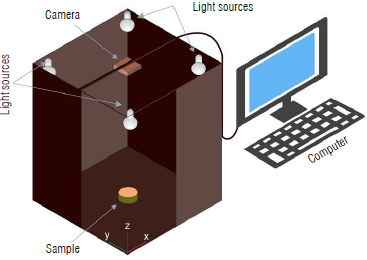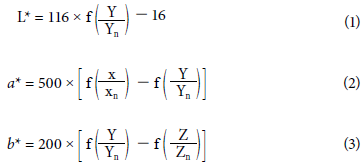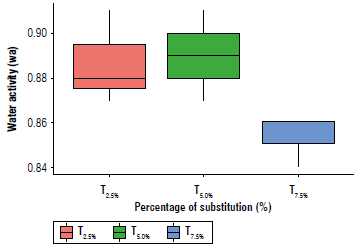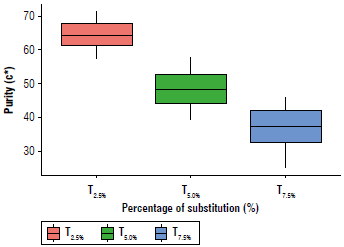Introduction
Tomato sauce is the most consumed tomato by-product in the world. The USA is one of the main exporters to the rest of North America, Japan, South Korea, and many European countries, making this market very dynamic (Valenzuela et al., 2018; Subroto et al., 2020). Commercial tomato sauce contains vinegar, sugar, salt and various spices, that are used to modify or intensify the flavor and aroma of various foods in the culinary world. From this viewpoint, consumers want sauces to have the characteristic red color, consistency, flavor, and aroma (Ahouagi et al., 2021).
In the food industry and gastronomically, new product proposals are increasingly generated that satisfy the consumer gustatory sensibilities and that additionally provide functional properties through their ingredients that contribute to the health of the consumer (Garcia et al., 2016; Ahouagi et al., 2021; Uribe et al., 2021). The addition of additional ingredients to tomato can affect multiple sensory, rheo-logical, chromatic, and nutritional properties of tomato sauce (Mirzaei et al., 2018). Since the consumer is the last commercial link that determines the quality of a product, the main analyses to be performed are color, texture, and flavor; and these will determine the acceptance of the product (Uribe et al., 2021).
In the Andean region of South America, quinoa (Chenopodium quinoa) is considered a natural food resource of high nutritional value, recognized by the Food and Agriculture Organization (FAO); for the FAO (2011), the quinoa germ (quinoa seed embryo) is a product high in fat (28.0% in the germ and 0.7% in the endosperm) and protein (48.5% in the germ and 3.5% in the endosperm). Quinoa germ is a source of nutrients and bioactive compounds that may provide various health benefits. First of all, it is an excellent source of vegetable protein that makes it an ideal ingredient for people who follow vegetarian or vegan diets. Quinoa germ contains high quality protein and all the essential amino acids for human health; in addition, quinoa germ is also rich in antioxidants and anti-inflammatory compounds (Vega et al., 2010). These compounds of quinoa germ can help prevent chronic diseases such as diabetes, hypertension, and cardiovascular disease. Antioxidants may also help to prevent cell damage and premature aging, and this may have long-term health benefits and when added to a sauce or dressing would modify its nutritional and physicochemical properties (Repo et al., 2003). The objective of the present research was to evaluate the effect of quinoa germ on the chromatic properties of tomato sauce.
Materials and methods
Samples of tomato sauces
Tomato sauce samples were prepared using a standard recipe as described by the following: 73.27% ripe tomato fruits, 25.39% onion, 0.64% celery, 0.60% garlic, and 0.07% pepper. This recipe was developed at the Universidad Peruana Union, Campus Juliaca. Finally, the powder of quinoa germ (quinoa seed embryo) was added to the tomato sauce in the percentages 2.5%, 5.0%, and 7.5%, based on a weight/weight mixture.
Moisture and water activity
The moisture content of the treatments was determined by weight loss by drying in a forced air oven (KERT LAB ODHG - 9030B) at 80°C until constant weight was obtained; these tests were analyzed in quintupled. Water activity 13.55±0.44°C was measured with AQUALAB (METER Group) at room temperature.
Image acquisition system
The image acquisition system for this research (Fig. 1) has the following characteristics: (1) the walls have a dimension of 30 cm, internal color matte black; (2) equilateral white light bulbs (10 cm edge); (3) a 13 megapixel image resolution camera; (4) a computer with an Intel Core i3 processor with 4G of RAM. The extracted samples were subjected to image acquisition in *.jpg format (Joint Photographic Experts Group).
Determination of color parameters
The color indicators L* (lightness) and the degree of redness (ratio s*/b*, where a* red - green and b* yellow - blue), the RGB information of the ROI's was extracted, from which the color was calculated in CIELab coordinates and these tests were analyzed in quintuplicate. This conversion is a mathematical process that allows colors to be represented in a three-dimensional space that is based on human perception. The Equations used to perform this conversion are as follows:
where L* is the luminosity, a* and b* are the chromaticity coordinates, Y is the relative luminance of the sample in RGB, Yn is the relative luminance of a white reference color (for example, D65); X, Y, and Z are the trichromatic coordinates of the sample in RGB; Xn, Yn, and Zn are the trichromatic coordinates of a reference white color (for example, D65); f(t) is a nonlinear function used to adjust the response of the human eye to different wavelengths (Sharma et al., 2004).
From these coordinates, the purity (c*) was calculated from the following Equation:
Statistical analysis
An analysis of variance of a single factor (ANOVA) was applied at a significance level of P>0.05, adding quinoa germ flour at different concentrations (2.5%, 5.0%, or 7.5%) and applying a comparison by means (Tukey's test) and a linear regression analysis (Montgomery et al., 2021) to the data obtained through the equation:
where y is the response variable (dependent); m is the slope; X is the predictor variable and b is the constant of the equation.
To adjust the models for each treatment, the criteria suggested by Chambi and Torres (2021) were applied, in which we have the coefficient of determination R 2 .
Results and discussion
Moisture content
The moisture content analysis (Tab. 1) showed that T 2 S% is significantly different from the other treatments and was superior at 83.824%.
TABLE 1 Descriptive statistics of the moisture content of tomato sauce treatments.

Note: means that do not have the same letters are significantly different at the 0.05 significance level.
The reduction in moisture content by increasing the content of quinoa germ in tomato sauce (Tab. 1) agrees with what was found by Tomas et al. (2018), who stated that the addition of dietary fibers can reduce up to 24.9% of the moisture content.
Water activity (aw)
The distribution of water activity (aw) data showed that the boxes corresponding to T 2.5 % and T5.0% overlapped each other, unlike T7.5% with a lower range of data than those mentioned (Fig. 2).
The water activity of tomato sauces is in a range of 0.950.98 of which treatments T 2 S% and T5 0% are close to those already mentioned (Villalobos et al., 2020). In TZ5%, the content is lower than the other treatments because the germ content contains a higher proportion of protein, followed by lipids, dietary fiber, and minerals (Zhang et al., 2023). These abundant proteins have polar hydrophilic parts and charged side chains, that convert them into a three-dimensional protein-water-carbohydrate structure that prevents free water from remaining, but rather binds it to the structure (Espinosa-Pardo et al., 2020). The for the corn germ studied by Tapia et al. (2001) had values close to 0.6. Likewise, the addition of ingredients to tomato paste like carbohydrates generates a significant decrease in water activity (Diantom et al., 2017). But in contrast to this statement, Gerardi et al. (2018) found that the addition of anthocyanin extract does not modify water activity in tomato sauce reporting a value of 0.98 ± 0.02.
Chromatic properties
The chromatic properties (Tab. 2) of the treatments showed that T7.5% is more luminous in contrast to the others. Likewise, it is observed that this has a linear behavior with a positive slope (m=213.820) with a coefficient of determination (R2) of 0.928 with respect to the red/green coordinate (a*), indicating that all the samples tend towards red. T 2. S% was the sample of greatest intensity. In contrast to the luminosity this coordinate shows linear behavior with a negative slope (m=-590.850) and an R2 of 0.972.
TABLE 2 Chromatic properties of tomato sauces with a partial substitution of quinoa germ.
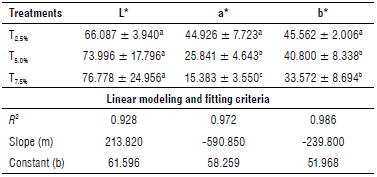
Note: All means are expressed as mean ± SD (n=5). The means that do not have the same letters are significantly different at the 0.05 significance level according to the Tu key test.
By adding additives to the sauce formulation, the brightness (L*) oscillated between the values of 42.73 and 52.19, demonstrating that there is an effect on the chromatic properties (Diantom et al., 2017). In this research, a considerable spread was observed in the luminosity with values between 66,087 to 76,778 (Tab. 2). This is due to the color of the quinoa. The same happens with the two remaining properties (a* and b*). Likewise, Pereira et al. (2022) in a study on the substitution of tomato for avocado in obtaining sauce, demonstrated that the samples with avocado had high luminosity and yellowing.
Regarding the calculation of purity (c*), the values decreased as the percentage of substitution increased in such a way that it is affected (Fig. 3).
Color purity in tomato sauce is an important aspect that can influence sensory perception and acceptability of the product by consumers. The addition of other raw materials such as spices can affect the color purity of tomato sauce and its visual quality. Color purity refers to the intensity of the dominant color in a sample and is measured using a spectrophotometer. The addition of spices to tomato sauce can decrease color purity due to the presence of additional pigments in the spices that compete with the pigments in tomato (Botello et al, 2015). Additionally, the amount and type of spices added can influence the color purity of tomato sauce. The addition of turmeric to tomato sauce can significantly decrease color purity compared to other spices such as black pepper and cinnamon (Opara & Chohan, 2014). It is important to note that, although color purity is an important aspect of the visual quality of tomato sauce, it is not the only factor to consider. The addition of spices and other ingredients can enhance the flavor and complexity of tomato sauce and may compensate for the decrease in color purity.
Conclusions
The addition of quinoa germ had a direct effect on the analyses carried out. The more germ added, the greater was the reduction in water content. With respect to the water activity the same trend happens as with the water content, and, finally, the chromatic properties varied in all the substitutions, presenting a linear behavior with a negative slope and with a coefficient of determination (R2) higher than 0.90.
The use of quinoa germ in the preparation of tomato sauce presents interesting chromatic properties, as well as an analysis of water activity and moisture. These aspects are relevant to assess the stability and quality of the product. By incorporating quinoa germ, a change in the chromatic properties of the sauce was observed, which can provide a distinctive visual appeal. Furthermore, the analysis of water activity and water content allowed for determining the water retention capacity and the stability of the product over time. These parameters are important to ensure proper texture and preservation of the quinoa germ-enriched tomato sauce.













